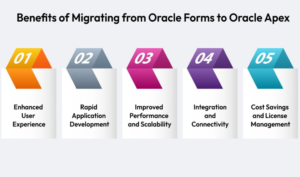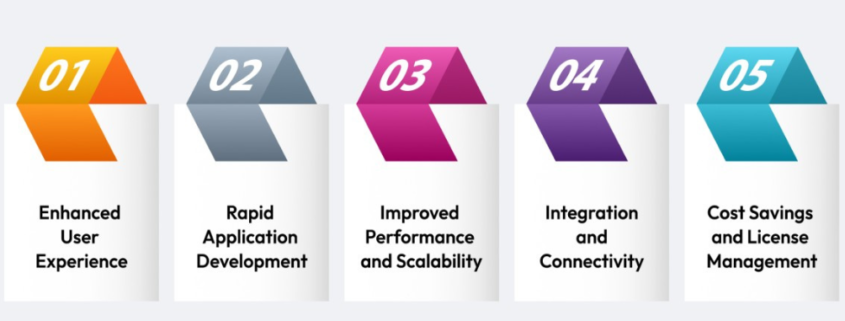Migrating from Oracle Forms and Reports to Oracle APEX
As businesses evolve, the need for modern, efficient, and cost-effective application platforms becomes essential. For organizations using Oracle Forms and Reports, transitioning to Oracle Application Express (APEX) is an excellent choice to embrace the modern web-based application development environment. This blog explores the key aspects of migrating from Oracle Forms and Reports to Oracle APEX, the benefits, and a roadmap for a successful migration.
As businesses evolve, the need for modern, efficient, and cost-effective application platforms becomes essential. For organizations using Oracle Forms and Reports, transitioning to Oracle Application Express (APEX) is an excellent choice to embrace the modern web-based application development environment. This blog explores the key aspects of migrating from Oracle Forms and Reports to Oracle APEX, the benefits, and a roadmap for a successful migration.
Why Migrate to Oracle APEX?
Oracle APEX is a low-code development platform that allows you to create scalable, secure, and responsive web applications. Here are some compelling reasons to make the switch:

Migrating from Oracle Forms to Oracle APEX
- Modern User Experience: APEX provides a modern, web-based interface that enhances user engagement compared to the outdated Forms interface.
- Cost Efficiency: As a part of the Oracle Database, APEX does not require additional licensing, making it a cost-effective solution.
- Responsive Design: Applications built with APEX are mobile-friendly and can adapt to various screen sizes and devices.
- Rapid Development: The low-code environment enables faster development cycles and quicker time-to-market.
- Integration Capabilities: APEX seamlessly integrates with RESTful web services, APIs, and other Oracle and non-Oracle systems.
Challenges of Migrating from Oracle Forms
Migration from Oracle Forms and Reports to APEX is not a simple lift-and-shift process. It involves rethinking the architecture and user experience. Key challenges include:
- Business Logic Migration: Oracle Forms heavily relies on PL/SQL triggers, which may need to be refactored for APEX.
- UI Redesign: Forms-based applications often have a desktop-oriented design that must be reimagined for the web.
- Report Conversion: Oracle Reports need to be recreated using APEX’s Interactive Reports, Classic Reports, or third-party tools.
- Skill Transition: Developers familiar with Oracle Forms need to upskill in APEX and modern web development practices.
Migration Roadmap
To ensure a smooth transition, follow these steps:
Assessment and Planning
- Inventory Analysis: Identify all existing Oracle Forms and Reports, categorizing them based on complexity, usage, and priority.
- Gap Analysis: Determine which features can be directly mapped to APEX and which need redesign or replacement.
- Define Objectives: Establish clear goals for the migration, such as improving performance, user experience, or scalability.
Skill Development
Train your development team on:
- APEX fundamentals and advanced features.
- Modern web development principles, including responsive design and JavaScript.
- Database design and optimization techniques.
Application Redesign
- UI/UX Modernization: Leverage APEX’s themes and templates to create a modern, user-friendly interface.
- Business Logic Refactoring: Extract PL/SQL logic from Forms and reimplement it as APEX processes, Dynamic Actions, or database-level packages.
Development and Testing
- Prototype: Start with a small, less critical application to test the migration approach.
- Iterative Development: Use APEX’s low-code features to build, test, and refine applications in iterative cycles.
- Testing: Perform rigorous functional, performance, and user acceptance testing.
- Data Migration
Ensure all necessary data is migrated from the Forms application to the new APEX environment while maintaining data integrity and security.
Deployment and Optimization
- Phased Rollout: Deploy applications incrementally to minimize disruptions.
- User Training: Provide end-users with adequate training and support to ease the transition.
- Monitor and Optimize: Continuously monitor application performance and user feedback to implement improvements.
Benefits of Migrating to Oracle APEX
- Enhanced Productivity: Faster development cycles and reduced maintenance overhead.
- Improved User Experience: Modern, responsive web applications that meet today’s user expectations.
- Future-Proofing: APEX’s regular updates and robust community support ensure long-term viability.
- Scalability: Easily scale applications to meet growing business demands.
Conclusion
Migrating from Oracle Forms and Reports to Oracle APEX is a transformative journey that modernizes your application landscape and aligns it with current technological trends. By carefully planning the migration process and leveraging APEX’s capabilities, you can create applications that are not only functional and secure but also future-ready.
If you’re considering this migration, Oracle APEX offers the tools and resources to make the process as smooth as possible. Begin your journey today and unlock the potential of modern application development!



